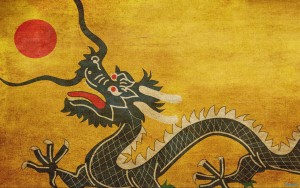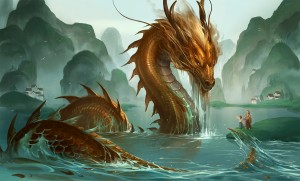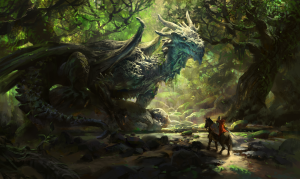“No, I would not want to live in a world without dragons, as I would not want to live in a world without magic, for that is a world without mystery, and that is a world without faith.” -R.A. Salvatore
Dragons have always been a significant part of almost every culture’s folkloric identity, and even centuries ago, not a single child could be found who never heard tales of these mythical beasts. The image of the enormous, lizard-like creatures appears on the pages of the ancient English lexicons, on the Viking vessels, or even on the flags of the Chinese Zhou dynasty. Though folklorists still argue over the root of the dragon myths from all over the world, the logical explanation would be the discovery of the dinosaur fossils, which were discovered as a result of erosion. Later, the ancient civilizations shaped their own belief system around these gigantic and mystical bones.

Flag of the Chinese Zhou dynasty

‘Humbaba’ from the Epic of Gilgamesh
The earliest recorded data of a dragon dates back to 2000 BC, when the famous Epic of Gilgamesh was written. ‘Humbaba’, as the text indicates, was a fearsome, fire-breathing, draconic demon, created by Enlil, the chief deity of the Sumerian mythology, for the purpose of guarding a venerable forest. As time went by, the representation of the dragon div ided into two main parts: the Eastern tradition and the Western tradition. According to the Eastern folklore –the folklore of China, Korea, and Japan –, dragons, or ‘Lungs’, are wingless, snake-like, celestial beings, and they are the symbol of sanctity and good fortune. Instead of breathing fire, they exhale divine energy, which is also known as the ‘essence of life’. They are the holy creators of rain and thunderstorms, and unlike their Western counterparts, Lungs tend to live in ponds and in other forms of water.
ided into two main parts: the Eastern tradition and the Western tradition. According to the Eastern folklore –the folklore of China, Korea, and Japan –, dragons, or ‘Lungs’, are wingless, snake-like, celestial beings, and they are the symbol of sanctity and good fortune. Instead of breathing fire, they exhale divine energy, which is also known as the ‘essence of life’. They are the holy creators of rain and thunderstorms, and unlike their Western counterparts, Lungs tend to live in ponds and in other forms of water.
The image of a Western dragon, however, is usually what people are introduced to in traditional European fairytales and in modern Hollywood movies. In these stories, the dragon abhors and terrorizes humans, lays waste to the nearby villages, and defends their treasure at all costs. They are greedy and sly, live in the caves of the misty mountains, and breathe fire or poisonous gas. They are fulfilling the role of the villain, and the hero’s main task is destroying the beast, which leads to the reputation and respect of the community. This classical Western image of the dragon could be seen in the famous legend of Saint George and the Dragon, in Beowulf, or in one of the most famous fantasy books of the twentieth century, the Hobbit.
However, as the twenty-first century came closer, a drastic shift from the traditional dragon depiction has transpired: the image of the violent beast has become a tamable and wise being, standing above humans both morally and intellectually. Series like Te meraire, the Inheritance Cycle, Dragonriders of Pern, and How to Train Your Dragon work with this new portrayal. I’m one of the few kids I know who didn’t really want a pony when I was growing up: I wanted a dragon. This is reason why I chose these beasts as my research topic in these blog posts. I’m also intended to find out why the portrayal of the dragon changed during the years: Is it just the wave of modernity in literature, or is there a hidden psychological aspect behind this shift?
meraire, the Inheritance Cycle, Dragonriders of Pern, and How to Train Your Dragon work with this new portrayal. I’m one of the few kids I know who didn’t really want a pony when I was growing up: I wanted a dragon. This is reason why I chose these beasts as my research topic in these blog posts. I’m also intended to find out why the portrayal of the dragon changed during the years: Is it just the wave of modernity in literature, or is there a hidden psychological aspect behind this shift?
Picture sources:
- http://mikeazevedo.deviantart.com/art/Joseph-the-Ancient-forest-dragon-456200792
- http://www.deviantart.com/art/river-282659319
- https://s-media-cache-ak0.pinimg.com/originals/04/76/d2/0476d2cbaaccebf1bf8af1206083f730.jpg
- https://neptunesauraastrology.files.wordpress.com/2014/03/800px-chaos_monster_and_sun_god.png

